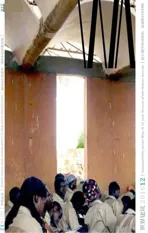水之力量
2016-12-21马里乌斯·罗通艾格
水之力量
Te Power of Water
路易吉·森托拉喜欢在水中和水边放松身心。水的力量也推动了这位罗马建筑师的最重要的项目,并确保这世界上最美地方之一的文化遗产能够得以保存。
“我是大海的儿子,” 路易吉·森托拉说,“我最喜欢的消遣是游泳和钓鱼。” 不足为奇,这位建筑师,生于1968年,长于港口城萨莱诺市;他的业余时间几乎都是在这号称世界最美的沿海地区之一的阿马尔菲海岸附近度过。路易吉·森托拉不仅是大海之子,而且也是语言大师。如果不是离开他的周末度假别墅到岸边跃入碧波中游个畅快淋漓,或是驾一叶小舟顺水漂流,那他一定就是在与人交流。他的手机不停地响;走在大街上,不断有汽车停在他身边,因为司机们都认识他,想跟他打招呼。
以互动为生活原则
路易吉·森托拉不仅在郊游时享受与他人的交流,而且在日常职业生活中也是如此。作为建筑师,他建成的高楼大厦尚不是很多,但他参与过的项目数不胜数。他就职于各个大学,筹划各种竟赛,与当局谈判,与专家协调、对话——总是沉着冷静且富有幽默感,但总是目标明确。意大利人的典型日常就是与人交往,森托拉对此深信不疑。“在意大利的乡村或城市,最好和最重要的地方是广场,中央广场。傍晚,广场上不再炎热的时候,男女老少,各色人等来这里聚会。人们在这里谈天说地,嬉笑怒骂,故事讲得绘声绘色、引人入胜。即使是最受欢迎的电视节目也无法影响意大利广场的生活。
他的脑海中有一个广场
在某种意义上来说,路易吉·森托拉将他的广场随身携带——广场就在他的脑海里。这里有各种想法孕育、争吵、组合、茁壮成长。他说,他的力量是远见,而不是空中楼阁。“我以开放的态度在各个技术学科与各个领域的专家合作;我寻求与政客、赞助商、客户联系。我的项目有些只是提案、雄心勃勃的意图——但总是脚踏实地。”令森托拉感兴趣的建筑不仅仅是建筑物。“我的建筑必须与考古学、地理学、基础设施、政治战略、社会问题和生态学有关。”最能说明这一点的莫过于“穆里尼改造战略”项目了,他凭借该项目荣获欧洲地区豪瑞奖金奖、全球豪瑞奖银奖——该项目位于路易吉·森托拉生活的中心——阿马尔菲。
落入人间的天堂
“但阿马尔菲的人在审判日升入天堂的时候,这一天对他们来说与其他任何一天都毫无二致。”这是写在阿马尔菲入口处一个标牌上的话,意译大致如此。这个小镇坐落在粗犷的海岸线上,风景如画,简直是人间小天堂——正因如此,在炎炎夏日,到处是蜂拥而至的游客。阿马尔菲的神奇难以言绘。似乎每一块石头都饱含着历史。千百年来,这个小镇一直是全球性的游玩圣地,如今镇上已有5,500名居民。海上共和国阿马尔菲控制了该地区的大部分领地和国际贸易。来自意大利南部的商人在他们的旅途中了解了世界的秘密。在12世纪,他们在中国看到了如何造纸,同时也把柠檬带回了家乡。从那时起,阿马尔菲就以柠檬和纸张而闻名。柠檬梯田果园广泛种植,鳞次栉比,构成独特的景观。造纸推动了经济发展,用旧衣服破布制造的阿马尔菲纸成为龙头出口产品。小镇后面沿坎奈托河一带先后建起了无数小型造纸厂。从阿马尔菲望去,这些造纸厂连成一串,向内陆方向延绵3km,海拔从40m升到225m的高度。这些造纸厂经过几个世纪的精心打造,其间有足够的距离,以最大限度的保存水力。
濒危遗产
造纸厂给了人们工作,有些人靠造纸致富,甚至大富大贵。但这是很久以前的事了。当人们从远方沿着海岸公路或从海上来到阿马尔菲的时候,这个小镇依然焕发着力量与信心。但是在这光芒四射的小镇后面,“纸厂山谷”绵延在高山丘陵和老树之间,阿马尔菲呈现出截然不同的面貌,满目沧桑。几十年前,这些小厂还在生产一度风行的纸张,如今早已破败不堪。
到了现在,在2016年的夏天,它们成了令人印象深刻的废墟和阿马尔菲美好过往的见证。除了旅游业,该地区几乎没有任何企业为人们提供工作和收入。“每年寥寥几个月的旅游业不足以维持阿马尔菲的生存,” 路易吉·森托拉如是说。年轻人,特别是受过良好教育的年轻人,都想迁往城市。“这除了导致人口问题外,还会造成很多后果。海岸文化遗产有可能消失殆尽。”没有了解并保持当地传统的居民,阿马尔菲就失去了根。虽然还有许多梯田柠檬果园代表小镇历史,但很多其他的历史遗迹都已经无可挽回地毁灭了。阿马尔菲的人工采摘柠檬没有一丝机会在国际市场上与工业生产的柠檬竞争。
文化热点
早在几年前,联合国教科文组织就呼吁地中海国家保护其梯田山坡,这些山坡是这一带海岸的独特风光,令人印象深刻。很多人还希望保存阿马尔菲光辉经济历史的活化石——造纸厂。几年前,萨勒莫大学的地理学家玛利亚-焦万娜·里塔诺教授开始将濒危建筑物登记为历史建筑,指定40处建筑废墟作为区域传统的重要样本。其中有15处位于纸厂山谷——遗产热点。并决定在这里启动一个大型试点项目。2004年,路易吉·森托拉,这位热爱这个地区并了解这里所有人民的富有远见卓识的传播者,受该大学和萨勒莫省的委托,制定了穆里尼山谷总体发展计划。
由水驱动
路易吉·森托拉的设计理念预见到将山谷进行彻底改造,以发展现代化可持续型旅游业。穆里尼山谷不应变成木乃伊,也不应变成博物馆,而应开
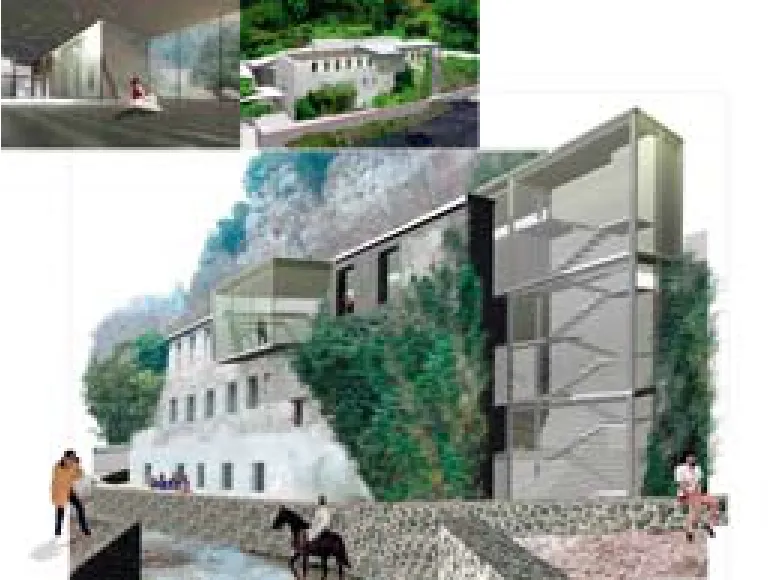
3 曾经的水电站改造成水力博物馆和全景酒吧/Hydraulic museum and panoramic bar in a former hydroelectric power plant
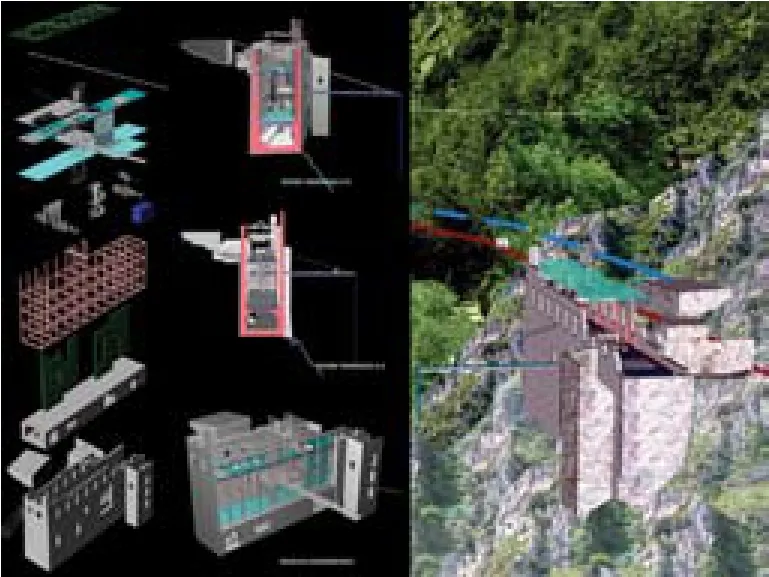
4 水务及步道/Waterworks & promenade
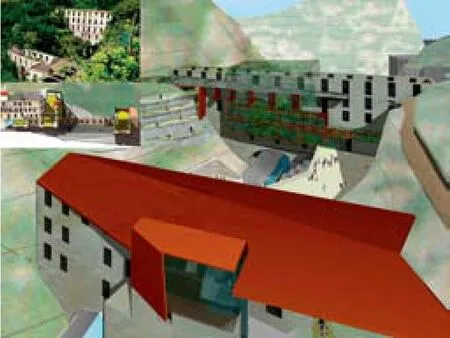
5 曾经的造纸厂改造的地中海健康水疗中心/Mediterranean health spa in the former Lucibello-Confalone paper mill
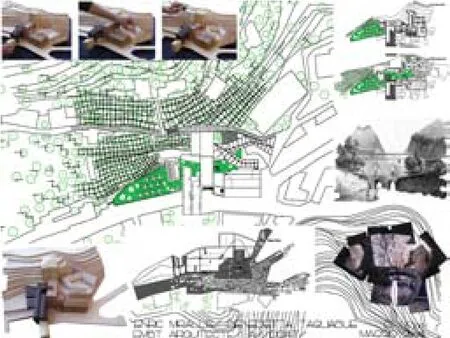
6 柠檬梯田酒店/Lemon terraces hotel
Luigi Centola is relaxed in and around water. Te power of water also drives the most important project of the Roman architect – and could ensure that the cultural heritage of one of the world's most beautiful places is preserved.
"I am a man of the sea," tells Luigi Centola. "My favorite pastimes are swimming and fishing." No wonder – the architect, born in 1968, grew up in the port city of Salerno; he spends nearly all his free time at the nearby Amalfi coast, considered one of the most beautiful coastal areas in the world. Luigi Centola is not only a man of the sea, but a man of the word. When he is not plowing with sure strokes through the emerald-green waves off the shore from his weekend house, or drifting about on his small boat, he is practically always communicating. His cell phone rings continually; on the street, cars stop him again and again because the drivers know him and want to say hello.
Interaction as a principle of life
Enjoyment of exchange with others typifies not only his outings, but also his everyday professional life. Luigi Centola is not an architect who builds a lot (yet), but one who is involved in uncounted projects. He works for various universities, conducts competitions, negotiates with authorities, coordinates, talks with specialists – always calmly and with a sense of humor, but always with purpose. Centola is convinced that interacting with people is typically Italian. "Te best and most important place in an Italian village or city is the piazza, the central square." Here the people meet in the evening, when it's no longer so hot – old people, young people, women and men. Here the talk, the scolding, the laughter, the story-telling is wild and gesticulated. Not even the popular television set has been able to sweep life from the Italian piazza.
A piazza in his head
In a certain sense Luigi Centola carries his piazza along wherever he goes – in his head. Here ideas grow, quarrel, com-bine, thrive. His strength, says he, is vision – but not of castles in the air: "I work openly in various technical disciplines with specialists from all areas; I seek contact with politicians, sponsors, clients. Some of my projects are only proposals, ambitious intentions – but they are always realistic." Te architecture that interests Centola consists of much more than just buildings. "My architecture has to do with archeology, with geography, infrastructure, political strategies, social issues and ecology." Tere is no better exam-ple to illustrate this than the project "Renewal Strategy for the Mulini Valley," for which he won the Holcim Award Gold for the region Europe and the global Holcim Award Silver – and which is situated at the center of the universe in which Luigi Centola lives: in Amalfi.
Paradise falling
"When the people of Amalfi enter paradise on Judgment Day, this will be a day just like any other for them," it is written, freely translated, on a sign at the entrance to Amalfi. The town, picturesquely situated on the brusque coastline, is actually a little paradise on earth – which is why in the warm summer months it almost drowns in swarms of tourists. Amalfi has a magic that is hard to describe. Each stone seems to breathe history. For hundreds of years this small town, which today counts 5,500 residents, was a global player. Te maritime republic Amalfi controlled a great part of the region and the international trade. On their journeys the merchants from southern Italy became acquainted with the secrets of the world. In the 12th century they saw in China how paper is made, and in that era they brought home the lemon. From that time on, Amalfi would be known for its lemons and paper. Lemons shaped the landscape, as terraced lemon orchards spread extensively. Paper drove the economy, as Amalfi paper – made from old clothing – became a leading export product. Countless small paper factories sprang up along the small Canneto River in the ravine behind the town. From Amalfi the chain of mills stretched 3 kilometers inland, climbing from 40 to 225 meters in elevation. The mills were carefully built over the centuries with enough space between them to optimally conserve the waterpower.
Threatened heritage
The paper factories gave people work and made some of them rich, even very rich. But that was long ago. Amalfi still radiates strength and confidence when one approaches the town along the coastal road or from the sea. But behind the radiant town, where the "valley of the mills" stretches in the shadow of high hills and shade of old trees, Amalfi shows a completely different face – one that speaks of downfall. Te mills, where the once-fashionable paper was produced until a few decades ago, have long since deteriorated. Now, in the summer of 2006, they stand as impressive ruins and reminders of better times at Amalfi. Besides tourism, there are hardly any businesses left in the region that offer people work and income. "The few months of tourism each year is not enough to keep Amalfi alive," says Luigi Centola. The young people – especially the better educated ones –are moving to the cities. "This causes more than demographic problems. Te cultural heritage of the coast threatens to vanish." Without a population that knows and upholds local traditions, Amalfi will lose its roots. There are still many terraced lemon orchards with a lot of his-tory, but many others have already been hopelessly destroyed. Te hand-picked fruits from Amalfi have no chance to compete against industrially produced lemons on the international market.
Cultural hotspot
Already years ago UNESCO appealed to the Mediterranean countries to con-serve their terraced slopes, which so impressively characterize the coastlines. Many people also want to save the stone remains of the proud economic history of Amalfi –the paper mills. A few years ago Professor Mariagiovanna Riitano, geographer at the University of Salerno, began registering the endangered structures as historic buildings, designating the ruins of 40 buildings as significant examples of regional tradition. Fifteen of these buildings are in the valley of the mills – a hotspot of heritage. Te decision was made to launch a large pilot project here. In 2004 the university and Salerno Province commissioned Luigi Centola, the visionary communicator who knows all the people here and loves the region, to develop a master plan for Mulini Valley.
Driven by water
Te concept that Luigi Centola devised foresees the complete renewal of the valley for modern and sustainable tourism. Mulini Valley is not to be mummified – or museumified – but is to develop a whole new dynamic. Cen-tola's master plan includes 11 sub-pro-jects, each for a different former paper factory. These include hotels, artist studios, a museum, a parking garage at the entrance to the valley, and so forth. The plan calls for renovating 20,000 square meters of building substance.
The sub-projects all support one over-arching idea: returning vitality to the original driving force of the valley, waterpower. Tere were never motors in Mulini Valley because the mills were powered by the Canneto. The paper sheets were carried by发一个全新的动力。森托拉的总计划包括11个子项目,每个项目各针对一个旧造纸厂。其中包括酒店、艺术工作室、博物馆、山谷入口处的停车场等等。该计划要求翻新20,000m2的建筑物。
这些子项目都支持一个总体理念:给山谷的原始驱动力——水力,重新注入活力。穆里尼山谷从未用过电机,因为这些纸厂都是靠坎耐托河提供动力。 造出的纸全部由驴子驮进城里。从未建成一条街——所以在将来,人们到达穆里尼山谷改造后的建筑不是乘汽车,而是靠3种类型的水力电梯:浮动平台、压力和可变重量。还将建造一条水力索道来运输材料和货物——包括柠檬。
当初唯一可用而今最干净的能源
森托拉的计划要求在3个关键方面使用水。首先,恢复水渠系统为梯田排屋提供水和空调。其次,水力驱动水力机械:电梯、起重机、泵、运输和冷却系统。第三,水力将被用作可再生能源。各种应用显示了使用水力来提供能源的多种选择。“每个子项目都有技术创新;替代性能源无处不在,” 森托拉自豪地说,“我们的祖先使用水,因为那时在山谷中水是唯一可用的能源;如今我们使用水,因为水是干净的能源。”
国际性跨学科团队合作
森托拉为每个子项目各聘用一个建筑师或办公室。共有来自意大利、西班牙、美国和英国的150人,制定了山谷改造战略的细则。这种国际性跨学科团队合作是许多可持续建筑项目的特色。有些顾问已经与森托拉相识多年;有些建筑师曾在意大利或英格兰与他一起求学。“所有人员都非常适合这个项目,”他说,“他们具备必要的技术知识和正确的愿景。”随着各种设想的被研究、讨论、驳回、修订和发展,这个项目成为一种平台,一个广场。“即时这个过程不会使工作更容易,我也从一开始就知道,我希望与许多不同的建筑师共同为此努力,” 路易吉·森托拉说,“这让山谷名副其实地丰富多彩!”
500份工作,1000名游客
尽管有国际参与,但本战略绝不是强加给本地人的外国专家的创造。路易吉·森托拉不断地咨询区域专家,因为“这样一个项目只有靠深刻了解本地的人才能实现。我们所需要的知识源于此处。比如,我们正与那些指导如何在当地条件下建造干瓦石墙的人合作”。本项目几乎没有遇到任何阻力;在阿马尔菲,每个人都与柠檬和造纸传统有关——爷爷在造纸厂工作;家里一直种柠檬。在展览会上展示本项目并与人们讨论。“年轻人反应热烈。老年人当然有些恐惧。”但在此期间,他们开始相信本项目的长期重要性;穆里尼山谷的复兴最终将创造大约500个长期工作。据估计,每天将有1000名游客来到翻修一新的建筑中参加会议、享受悠闲的假期,或利用健康计划的优势。游客可以在各类酒店的300张床位中自由选择。
所需行动
在第一批客人能够在纸厂山谷过夜的时候,将有海水沿坎耐托河顺流而下。许多建筑物的状态极差,几乎没有一样东西可以用于新建筑——几段基础墙,一个基本的建筑理念——当然,还有无与伦比的位置。有人认为这些残破的废墟几乎永远也不能成为酒店或工作室。“但是,所有的东西都可以用钢筋来稳定。” 森托拉说。计划将旧结构包裹在钢架外壳中。“如果50年后,有人想出新的山谷改造方法,这些外壳很容易拆除——那时,就有人再次站在我们今天所站的地方。”建筑物的不利条件反倒是一个很好的项目合作伙伴,森托拉笑道,“如果我们现在什么都不做,这些建筑很快就会倒塌——如果倒进水里,就会导致很多问题,那会付出非常昂贵的代价。”
纯手工
因此,需要采取行动,并且,在任何情况下,都必须将大量的金钱投入的纸厂山谷中,森托拉的总计划所需要的投资额约为1.2亿欧元。其中的30%将由公共当局将捐助;其余资金须由私人投资者筹集。实现这个雄心勃勃的项目计划耗期10年。一个原因是,进入施工现场的通道状态太差。大型施工设备和机器无法像沿岸其他地方那样开进工地。“这里的法则是手工,” 森托拉说,“因此这里的修复费用是其他地方的两倍。”总计划要求将原有建筑材料回收再利用,这不仅是出于生态原因,也有经济原因。
“可持续发展将成为自然!”
阿马尔菲的历史以造纸和柠檬为核心,因此“穆里尼山谷水力改造战略”治理的不仅仅是工厂废墟。森托拉的目标是保存25hm2的梯田柠檬果园,如今这些果园很难到达、很难灌溉。“这是对保护文化遗产和当地经济的一个虽小但很重要的共享。如果我们不能保存这些果园,就会有2000名小生产者失去收入来源——阿马尔菲海岸也将失去其独特风貌。”在意大利,传统意识很强,可持续性建筑的重要性意识也在增长,路易吉·森托拉相信:“一百年前,罗马竞技场被用作采石场引不起任何人关注,罗马人还会把竞技场的大理石用到新建筑中。这在今天简直是不可思议的。人们已经开始反思,用不了几年,可持续性发展将是完全自然的。”也许,为了能够认识到景观的价值,有必要摧毁很多东西。“沿着海滩建造了丑陋的工业建筑——今天我们已经认识到它们的副作用,从经验中学到教训。”
不同时代之间的对话
因为总体计划在此期间获得了广泛的支持,所以对于路易吉·森托拉来说是没有任何问题的:“我们会认识到的。在两三年内,第一批建筑就会建成。”难道就没有迅速建成更多商业化的子项目(酒店、青年旅舍),而以可持续发展为导向的方面(关于水力、生态和文化遗产)可能被搁置一边的危险吗?森托拉犹豫了。他知道人们的务实主义。然后他说:“我认为不会出现这种情况。每个部分都与其他部分紧密关联。你不能只管一部分而置其他部分于不顾——没有水力,整个项目都会失去信誉。”游览过山谷或听说过本项目的每个人都应该明白以妥善且可持续的方式使用自然资源的重要性。路易吉·森托拉反复强调本项目的整体性有多么重要——这种整体性使它可持续。“我们不仅仅是修复老建筑,我们要在昨天、今天和明天之间建立一个对话。”不同时代之间的对话——这是既热爱传统也热爱现代化的传播者路易吉·森托拉理所当然喜欢的东西。“是的,这可能是我今生最令人兴奋的项目!”(马里乌斯·罗通艾格 文)donkey into the town. A street was never built –and so in the future one will reach the reno-vated buildings of Mulini Valley not by car but by waterpowered elevators of 3 types: floating platform, pressure, and variable weight. And a water-powered cableway will be built to transport materials and goods – including lemons.
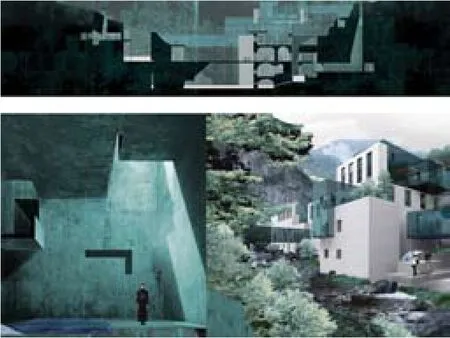
7 曾经的造纸厂改造成流水住宅及工作室与慢食中心/ Waterfall home + studios and slow food in the former Marino paper mill
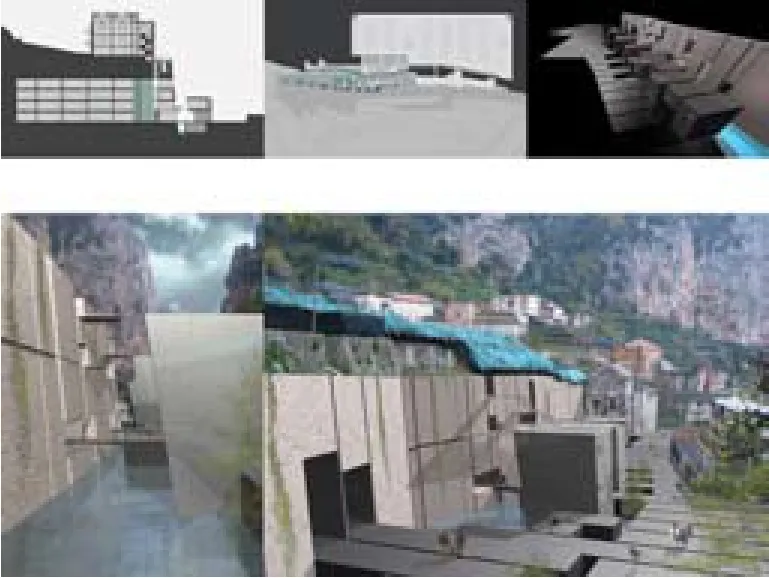
8 停车场与河道改造、地下车库/Car park and river remodeling, underground garage
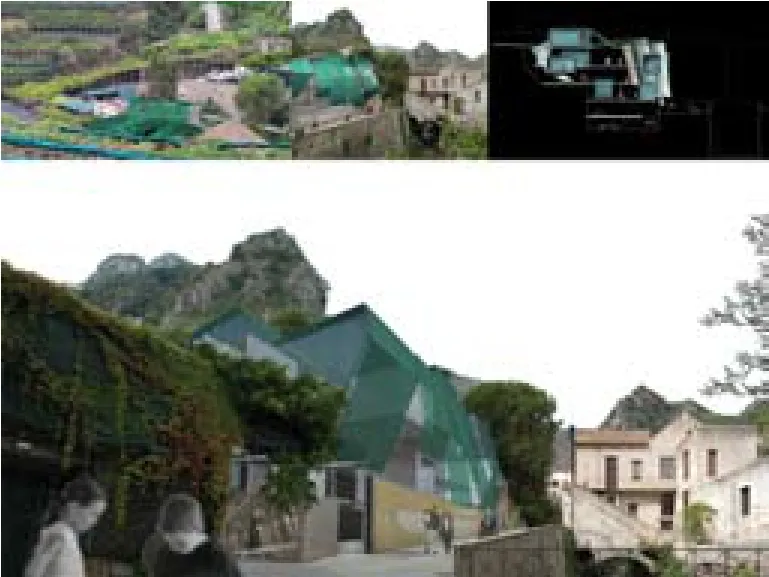
9 曾经的肥皂厂改为土特产商店/Local product shop in a former soap factory
Then the only energy source, today the cleanest
Centola's plan calls for using the water in 3 key ways. First, the water channel system will be restored to supply the terraced houses with water and air conditioning. Second, water will power hydro-mechanical machines: elevators, cranes, pumps, and transport and cooling systems. And third, waterpower will be harnessed as a renewable energy source. The various applications show the diverse options of using waterpower to supply energy. "Each sub-project is marked by technological innovation; alternative energy is involved everywhere," boasts Centola. "Our ancestors used the water because it was the only available energy source in the valley – we use it now because it is a clean energy source."
International and interdisciplinary teamwork
Centola hired another architect or office to handle each sub-project. 150 people in Italy, Spain, the USA and the UK, worked out the details of the renewal strategy. Such international and interdisciplinary teamwork is typical of many sustainable construction projects. Some of the consultants have known Centola for years; some architects studied with him in Italy or England. "All are extremely well suited for this project," he says. "They have the necessary technical understanding and the right vision." As ideas were studied, discussed, rejected, revised, and developed, the project became a sort of platform, a piazza. "Even if this process by no means made the work easier, I knew from the beginning that I wanted to work with many different architects on this," tells Luigi Centola. "Tis gives the valley true richness!"
500 jobs, 1000 visitors
In spite of the international participation, the strategy is not a creation of foreign specialists that is being forced on the locals. Luigi Centola constantly consults regional specialists because "such a project can be realized only by people who know the land. The knowledge we need originates here. We are working with people who know for instance how to build dry rubble stone walls under the local conditions." The project has hardly met resistance; in Amalfi everyone is associated with the tradition of lemons and paper – Grandpa worked in the paper mill; the family has always grown lemons. The project is presented at exhibits and discussed with the people. "Young people react enthusiastically. Older people of course have some fears." But in the meantime even they have become convinced of the long-term importance of the project; the revitalization of the Mulini Valley will ultimately create about 500 long-term jobs. One estimates that a thousand visitors a day will come to the renovated buildings to attend meetings, enjoy leisurely vacations, or take advantage of well-ness programs. Visitors will have a choice of 300 beds in hotels of various categories.
Action required
A sea of water will have flowed down the Canneto by the time the first guests will be able to stay the night in the valley of the mills. Many of the buildings are in pathetic condition; there is hardly anything here that could be used for new construction – a few foundation walls, a basic architectural idea – and of course the extraordinary location. One thinks the dilapidated ruins are hardly capable of some day housing a hotel or a studio. "But every-thing can be stabilized with steel," tells Centola. Te plan is to wrap the old structures in a steel-framed shell. "This can be easily removed say in 50 years, when one has new ideas for the valley – and then one will stand again where we stand today." Te poor condition of the buildings is a good project partner, chuckles Centola. "Te buildings will collapse soon if we don't do something now – and if one falls into the water it will cause a lot of problems and will be very expensive."
Only handwork
The need for action is thus given, and in any case a lot of money must be invested in the valley of the mills. Te investment called for by Centola's mas-ter plan amounts to about 120 million euros. Public authorities will contribute 30 percent; the rest must come from private investors. Te schedule for realizing the ambitious project extends over 10 years. One reason is that access to the construction sites is so poor. One cannot drive to the site with large construction equipment and machines, as one can everywhere else along the coast. "Here handwork is the rule," says Centola, "that's why restorations here cost about twice as much as elsewhere." Tat the master plan calls for the recycling and reuse of the original building material thus has not only ecological but also economic reasons.
"Sustainability will become natural!"
Amalfi's history revolves around paper and lemons, and therefore "Waterpower – Renewal Strategy for the Mulini Valley" treats more than just the mill ruins. Centola aims to conserve 25 hectares of terraced lemon orchards, which are now difficult to reach and irrigate. "Tat's a small but important contribution to the preservation of cultural heritage and to the local economy. If we fail to maintain these orchards, 2000 small producers will lose their income – and the Amalfi coast will lose its face." In Italy the awareness of tradition is great, and the awareness of the importance of sustainable construction is also growing, Luigi Centola is convinced: "A hundred years ago nobody cared that the Coliseum in Rome was being used as a quarry, that the Romans were taking the marble to use in new buildings. Today this would be unimaginable. A rethinking has occurred, and in few years sustainability will be completely natural." Perhaps to be able to recognize the value of the landscape it was also necessary to destroy a lot of things. "Horrible industrial buildings have been built along the beaches – today we recognize the negative effects and learn from the experience."
A dialog among the epochs
Because his master plan in the mean-time has gained very broad support, there is no question for Luigi Centola: "We will realize it. In two or three years the first buildings will be standing." Isn't there a danger that the more commercially oriented subprojects – the hotel, the youth hostel – will be built quickly and the sustainability-oriented aspects –regarding water power, ecology, and cultural heritage – might get pushed to the side? Centola hesitates. He knows the pragmatism of the people. Then he says: "I don't think so. Each part is strongly linked with the other parts. You can't do one part and leave the other out – without water-power the entire project would lose its credibility." Everyone who visits the valley or hears about the project should know how important it is to use natural resources in a thoughtful and sustain-able way. Luigi Centola repeatedly stresses how important the whole of the project is – this entirety is what makes it sustainable. "We are not just renovating old buildings – we are establishing a dialog between yester-day, today, and tomorrow." A conversation among the epochs –that's something the communicator Luigi Centola, who loves tradition just as much as modernity, of course likes. "Yes, this could be the most exciting project of my life!"(Text: Marius Leutenegger)
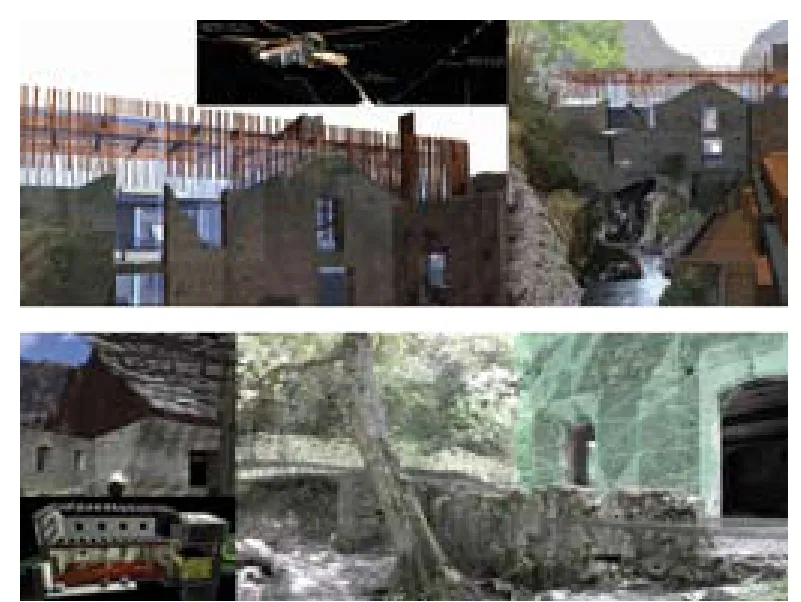
10 曾经的水电站改为可替代能源展示/Alternative energy display in a former hydroelectric power plant
